Vancouver Canucks Draft Strategy & Key Picks
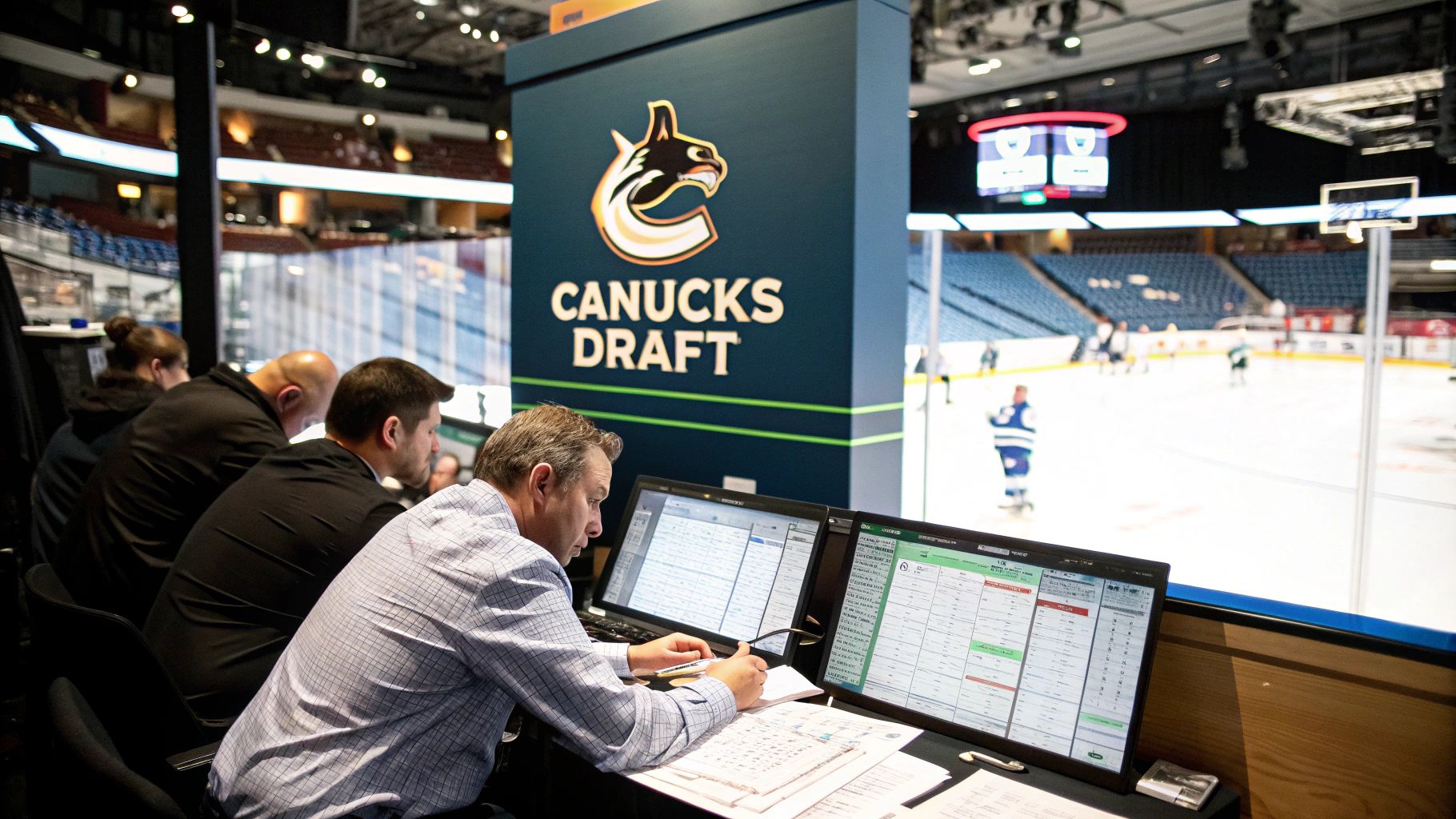
For any NHL team, the Entry Draft is a shot of pure hope—an annual injection of talent that can shape a franchise for a decade. For the Vancouver Canucks, draft day isn't just an event; it's where the future of the team is built, pick by painstaking pick. This is the primary pipeline for constructing a championship-calibre roster from the ground up.
Building a Contender from the Draft Floor
Every successful draft strategy for the Canucks boils down to one classic debate: do you take the best player available or draft for positional need?
It’s a bit like building a house. Sometimes you just need the absolute strongest foundation you can get—a potential top-pairing defenceman—no matter what other materials you already have. Other times, you’re missing a very specific tool to finish the job, like a pure goal-scorer.
This tug-of-war dictates nearly every move made at the draft table. Taking the "best player available" means grabbing the highest-end talent and worrying about roster fit later. On the other hand, drafting for need tackles an immediate hole, like a weak right-side defence or a thin depth chart at centre.
Global Scouting and Talent Pools
Making things even more complex is where all this talent comes from. The Canucks' scouting department operates globally, evaluating prospects from wildly different leagues and development curves. The Canadian Hockey League (CHL) is the most-scouted league in the world, and its physical, familiar style often makes its players a "safer" bet.
But sticking to the CHL means missing out on potential game-changers overseas. European leagues in Sweden, Finland, and Russia present a higher-risk, higher-reward proposition. These players are often developing against grown men, giving them a different kind of pro-level maturity. The incredible success of a player like Elias Pettersson is all the proof you need that finding gems abroad is essential in the modern NHL.
If you want to get into the nitty-gritty of how draft positions are set long before the picks are made, you can learn more about how the NHL lottery draft works in our detailed guide.
A successful draft isn't just about the first-round pick. It’s about finding valuable contributors in every round, building a sustainable pipeline of talent that can support the NHL club for the next decade.
The Importance of Every Pick
Ultimately, the goal is to build a deep, layered organization. While the first-rounders grab all the headlines, a truly great Canucks draft is often defined by the players found in the later rounds.
Finding a future NHL regular in the third, fourth, or even seventh round is what separates good drafting from elite drafting. Every single selection is a chance to add another piece to the long-term puzzle, ensuring the team stays competitive for years to come.
Franchise-Altering Moments in Draft History
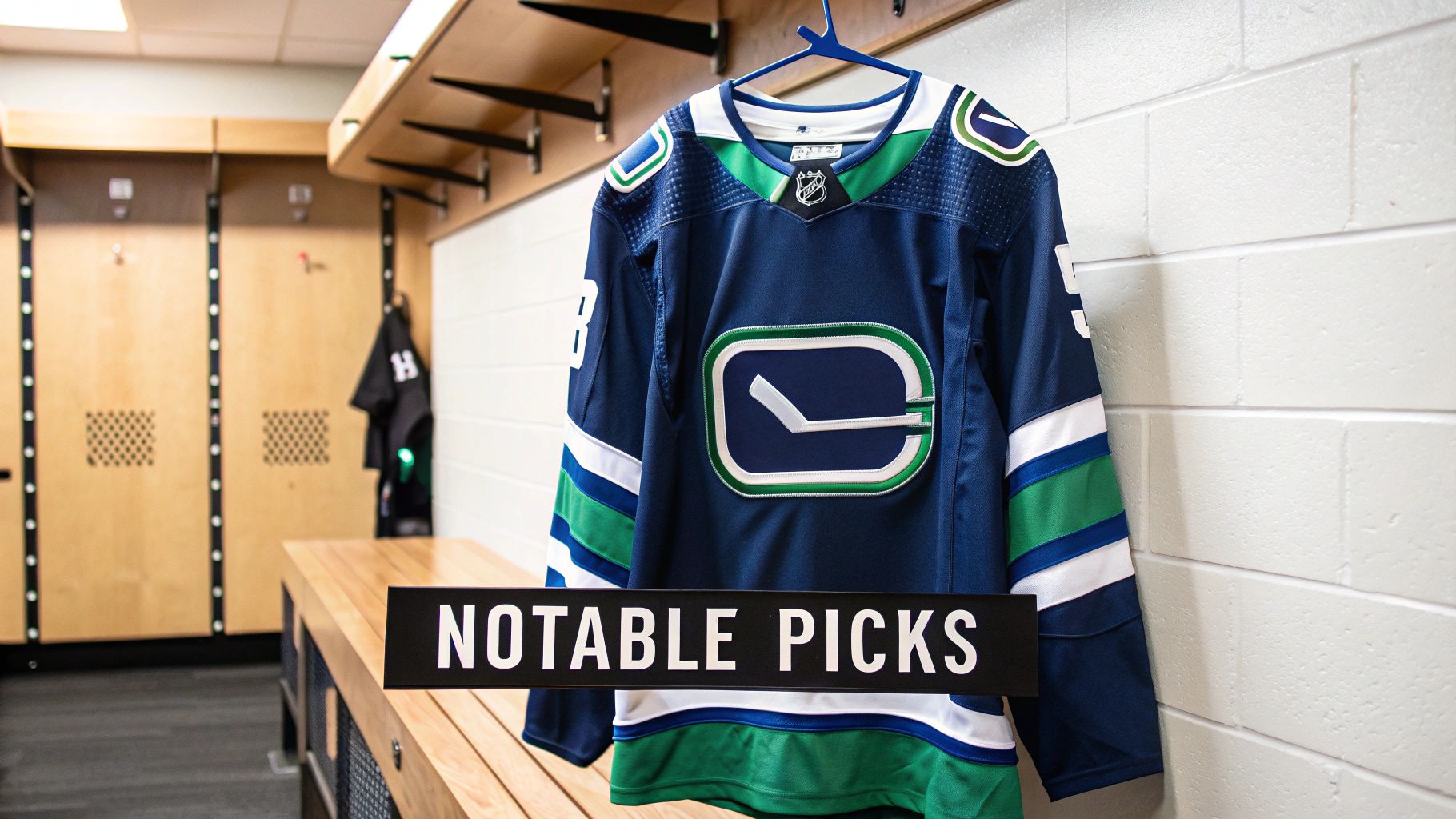 Every franchise has a few days that completely change its destiny, and for the Vancouver Canucks, those days often happened on the draft floor. A single name called from the podium can become the cornerstone of a golden era or a painful "what if" that fans debate for years. These high-stakes moments show just how thin the line is between a franchise-defining win and a major setback.
Every franchise has a few days that completely change its destiny, and for the Vancouver Canucks, those days often happened on the draft floor. A single name called from the podium can become the cornerstone of a golden era or a painful "what if" that fans debate for years. These high-stakes moments show just how thin the line is between a franchise-defining win and a major setback.
And no story captures this better than the legendary 1999 NHL Entry Draft. It remains the single most audacious and brilliant day in Canucks draft history. Then-General Manager Brian Burke walked into the arena with one wild, seemingly impossible goal: draft both Henrik and Daniel Sedin. The twin brothers from Sweden had made it clear they came as a package deal.
This wasn't just about picking two skilled players; it was a massive gamble to lock down the team's identity for the next two decades. In a masterclass of negotiation and sheer nerve, Burke engineered a whirlwind of trades to climb the draft board. He stunned the hockey world by securing the second and third overall picks, pulling off a move that nobody thought was possible.
The Sedin Masterstroke
The Canucks have seen it all at the draft table—massive wins and frustrating misses—but nothing tops what Brian Burke did in 1999. By wheeling and dealing his way into the #2 and #3 spots, he drafted Henrik and Daniel Sedin from MODO Hockey, and the rest is history.
Over their incredible 17-season careers in Vancouver, the Sedins played a combined 2,636 NHL games and racked up 2,111 points. They didn't just play for the Canucks; they became the Canucks. While the other six players Vancouver picked that year never made a real impact, it didn't matter. The twins alone made it arguably the greatest draft in franchise history. You can find more great analysis of the Canucks' draft history over at sportsnet.ca.
The payoff was immediate and profound. The Sedins became the heart and soul of the team, leading the Canucks through their most successful era, which included a Presidents' Trophy and a heart-stopping run to the 2011 Stanley Cup Final. They weren't just star players; their on-ice chemistry was so telepathic it looked like a magic trick, leaving defenders completely baffled for years.
The 1999 draft wasn't just a win; it was a franchise-defining jackpot. It proved that bold, calculated risks on draft day can deliver rewards that last a generation.
The Other Side of the Coin
Of course, for every home run like the Sedin draft, there are years that serve as a tough lesson. The team's history is also dotted with drafts that simply failed to produce impact players, reminding everyone just how difficult it is to predict how a teenager's career will unfold.
Think about the times a high pick just didn't work out. These moments are a harsh reminder that scouting is an imperfect science. Sometimes, even the most promising, can't-miss prospects don't develop the way everyone hoped. A first-round pick who plays less than 100 NHL games is a huge missed opportunity to add a key piece to the puzzle.
These highs and lows create the pressure-cooker environment of the draft floor. Every selection is dissected by fans and media, and each pick carries the weight of past triumphs and failures. The ghosts of drafts past are always lurking, influencing the decisions GMs make today.
- Triumph: Landing two franchise cornerstones in one afternoon (1999).
- Challenge: Using a top-10 pick on a player who never becomes an NHL regular.
- Lesson: A team's long-term health depends on finding value in every round of the draft, not just at the top.
This history is exactly what shapes the Canucks' modern draft strategy. The incredible success of the Sedin gambit encourages taking smart, calculated risks. At the same time, the memory of drafts that came up empty reinforces the need for meticulous scouting and a rock-solid development plan. The goal is always the same: repeat the wins and learn from the mistakes.
Decoding the Modern Canucks Draft Blueprint
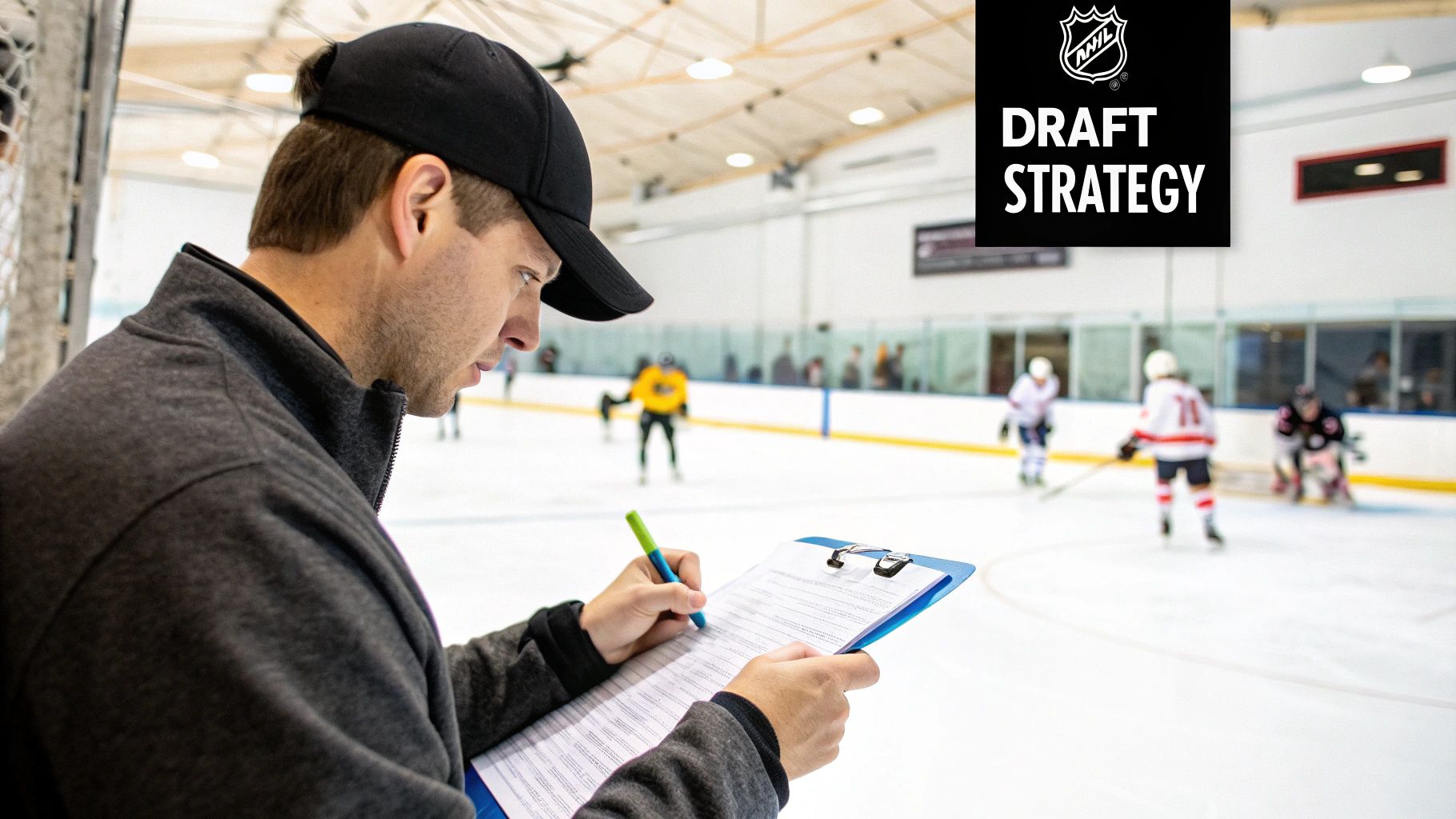 The days of building a team by simply picking from the familiar grounds of Canadian junior hockey are long gone. The modern Vancouver Canucks draft blueprint is now a global operation, laser-focused on finding specific skill sets from any league on the planet. As the NHL game gets faster and smarter, Vancouver's front office has adapted its strategy to stay ahead of the curve.
The days of building a team by simply picking from the familiar grounds of Canadian junior hockey are long gone. The modern Vancouver Canucks draft blueprint is now a global operation, laser-focused on finding specific skill sets from any league on the planet. As the NHL game gets faster and smarter, Vancouver's front office has adapted its strategy to stay ahead of the curve.
This isn't just about picking the so-called "best player available" anymore. It's about finding the right player who fits a clear vision for the team's future. The current approach involves a more thoughtful evaluation, balancing the perceived safety of a CHL prospect with the high-ceiling potential of a player developing in Europe. This worldwide scouting network is the engine driving their entire rebuild.
Looking back at the last 15 years, the team's first-round picks tell the story of this evolution. Between 2010 and 2025, the Canucks made 15 first-round selections, carefully mixing homegrown junior talent with international players who became cornerstones. Elias Pettersson, nabbed 5th overall from Sweden in 2017, is the perfect example—he's now the engine of the offence. This pattern of scouting both North America and Europe shows their commitment to leaving no stone unturned. If you want to dig into their first-round history, you can find more data on their draft picks at statmuse.com.
European Ventures and High-End Skill
The decision to draft Elias Pettersson in 2017 perfectly captured this modern philosophy. At the time, plenty of analysts were pounding the table for safer, North American-based prospects. But the Canucks' scouts saw something special in Pettersson’s creativity and elite hockey sense, skills he was already sharpening against grown men in the Swedish Hockey League.
That pick was a calculated gamble that paid off in a huge way. It signalled a major shift toward prioritizing raw, game-breaking talent, no matter where it came from.
The success of players like Elias Pettersson and Nils Höglander has validated the Canucks' investment in European scouting. It's a clear signal that they are willing to look beyond traditional talent pools to find players who can drive offence in the modern NHL.
This strategy requires a totally different kind of evaluation. Scouts have to project how a player’s skills will translate from the bigger European ice surface to the faster, more physical NHL game. That often means digging into advanced metrics to understand puck possession and play-driving ability, which are key indicators of future success. For anyone curious about the analytics that scouts use, you might find our guide on what Corsi is in hockey helpful.
Bolstering the Blue Line
Finding offensive dynamos is great, but you don't build a contender without a rock-solid defence. The 2023 Vancouver Canucks draft made that a priority, selecting Swedish defenceman Tom Willander at 11th overall. The pick was a clear statement: the organization is committed to shoring up its blue line with mobile, intelligent defenders.
Willander wasn't just another body; he was targeted for a very specific, modern skill set:
- Elite Skating: His ability to skate the puck out of trouble and close gaps defensively is exactly what you need in today's up-tempo game.
- High Hockey IQ: Willander consistently makes the smart, simple play under pressure—a trait this management group values immensely.
- Defensive Reliability: He projects as a dependable, two-way defenceman who can log tough minutes against the league's top forwards.
The choice of Willander shows a deliberate and focused strategy. It wasn't about just adding a defenceman to the prospect pool; it was about adding a specific type of player who fits the team's long-term identity. This is the modern Canucks draft blueprint in action: identify a need, scour the globe for the perfect fit, and draft the player whose skills directly solve that problem.
Measuring the Success Rate of Canucks Draft Picks
Beyond the hype and post-draft speculation, how can we really tell if a Vancouver Canucks draft was a success? It all comes down to the numbers. We need a simple, objective way to separate the guys who became long-term contributors from the prospects who never quite made the jump.
In hockey analytics, one of the most reliable measuring sticks is the 100-game NHL benchmark. Think of it as a prospect’s graduation day. If a player hits that milestone, they’ve officially transitioned from a hopeful pick into a legitimate, full-time NHLer. It proves they have the skill, durability, and consistency to stick around.
Looking back at the Canucks’ draft history, their success rate in turning picks into NHL regulars has been a bit of a rollercoaster. Over the past two decades, only about 40-50% of their selections have managed to hit that 100-game mark. It’s a stark reminder of just how unpredictable drafting can be, where even a "can't-miss" prospect faces a tough road to a stable career. You can find in-depth data on Canucks draft picks by year at quanthockey.com to see the year-by-year results for yourself.
The 2004 Draft as a Gold Standard
If you want to see what a truly exceptional draft looks like, you don't have to look much further than the class of 2004. That year was a masterclass in finding value all over the draft board, producing multiple long-term, impactful players who became cornerstones of the franchise.
The 2004 draft wasn't about one home-run pick; it was about depth and quality. Out of just seven selections, an incredible four players went on to play over 400 NHL games each. That kind of return is almost unheard of and shows a scouting department that was absolutely locked in.
This draft class included:
- Cory Schneider (G): A first-round pick who developed into a top-tier starting goalie.
- Alexander Edler (D): A third-round gem who became the franchise leader for defencemen in games played and points.
- Jannik Hansen (F): A ninth-round longshot who carved out a fantastic career as a speedy, reliable forward.
This success really drives home a critical point: a great draft builds a foundation, not just a single pillar. Evaluating how a team performed in a given year is a key part of assigning them a grade, and if you're interested in the methodology, you can read our guide on how NHL draft grades are determined.
The infographic below shows how prospects are ranked leading into the draft, which is the process teams use to figure out their top targets.
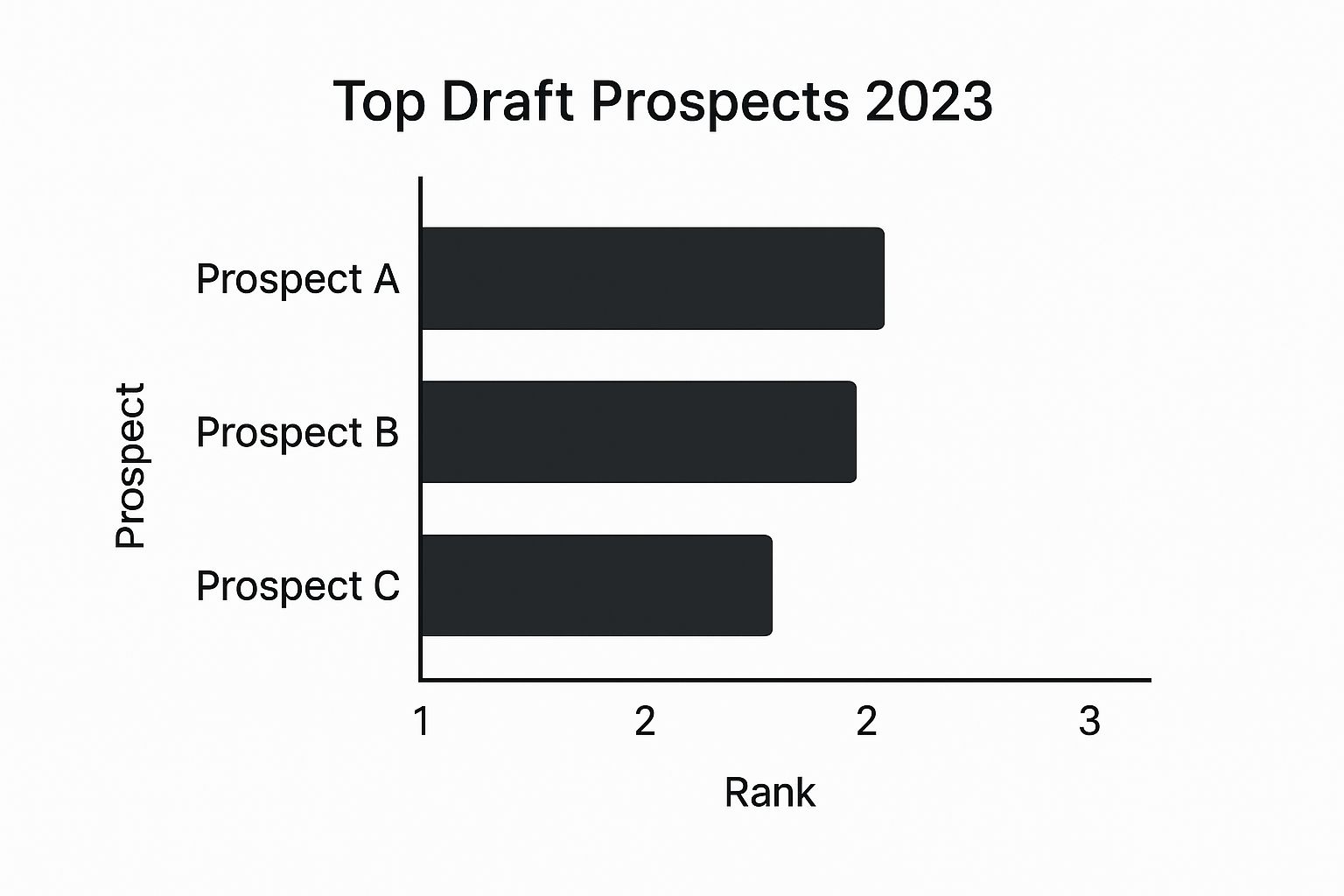
This chart makes it clear just how much perceived value is loaded at the very top of the draft board, where teams are swinging for franchise-altering talent.
The Ripple Effect of a Great Pick
The value of a successful draft pick often goes way beyond their on-ice performance. A smart selection becomes a massive team asset—one that can be used to acquire other key pieces down the line. The Cory Schneider pick is the perfect example of this powerful ripple effect.
Schneider was an excellent goaltender for the Canucks, but his true value was fully realized when the team committed to Roberto Luongo. Schneider’s high trade value allowed the Canucks to flip him for the 9th overall pick in the 2013 NHL Draft.
A successful draft pick is an appreciating asset. Their initial selection is just the beginning of their potential value to the franchise, which can multiply through strategic trades and roster management.
With that pick, Vancouver selected Bo Horvat, who became the team’s captain and a core player for nearly a decade. That chain of events—drafting Schneider, developing him into a star, and then trading him for a future captain—shows how one savvy selection can pay dividends for years. It’s a testament to how the Vancouver Canucks draft can shape a team's destiny in more ways than one.
Meet the Next Wave of Canucks Talent
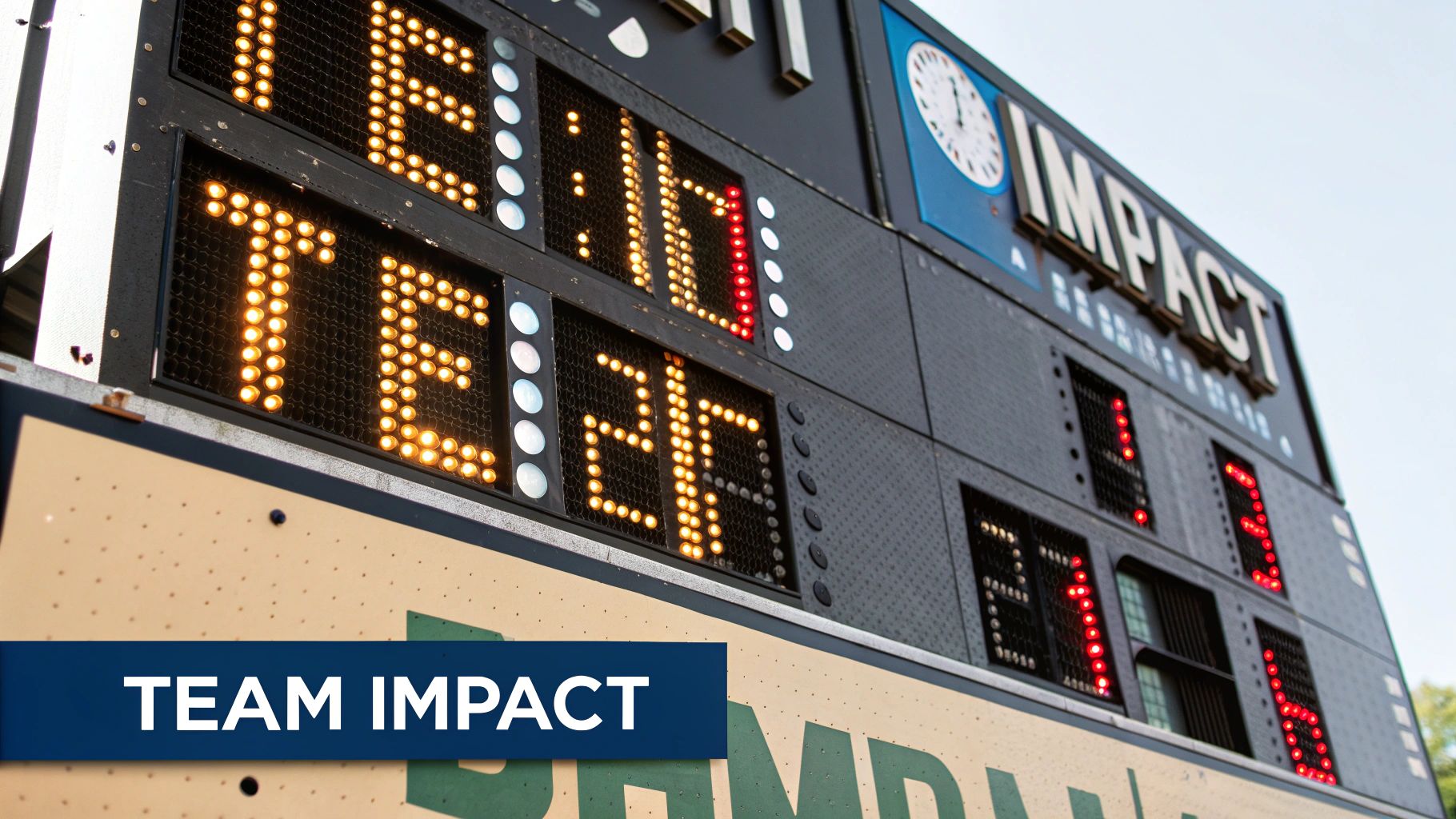 After digging through the draft history, it's time to shift our focus from the past to the future. Because at the end of the day, the true measure of any Vancouver Canucks draft is how many of those picks eventually pull on a Canucks jersey. The prospect pipeline is the lifeblood of any successful team, and right now, Vancouver’s is brimming with talent developing all over the hockey world.
After digging through the draft history, it's time to shift our focus from the past to the future. Because at the end of the day, the true measure of any Vancouver Canucks draft is how many of those picks eventually pull on a Canucks jersey. The prospect pipeline is the lifeblood of any successful team, and right now, Vancouver’s is brimming with talent developing all over the hockey world.
These are the names you’ll want to remember. They’re the next wave hoping to one day hear their names announced at Rogers Arena. Each player brings something different to the table—a unique skill set, a different path—and the potential to become a key piece for this team down the road. Let’s get to know the players who could define the next era of Canucks hockey.
The Crown Jewels of the System
Not all prospects are created equal. Every system has a handful of players with that special something—the high-end potential to become genuine difference-makers. For the Canucks, these are the guys fans should be watching closely, as their development is absolutely crucial for the team's long-term success.
Jonathan Lekkerimäki (RW) This kid is a pure sniper, plain and simple. Lekkerimäki has one of the most lethal shots you’ll find outside the NHL. His 2023-24 season in the SHL was a massive step forward, proving he can light the lamp against seasoned pros.
- Strengths: An absolutely elite wrist shot and one-timer. He’s a ghost in the offensive zone, always finding open ice, and a killer on the power play.
- Weaknesses: His game away from the puck still needs work. He’ll also need to add some strength to consistently win battles along the boards.
- NHL ETA: Look for him around 2025-26. He’ll almost certainly start in the AHL to get used to the smaller North American ice.
Tom Willander (D) Taken 11th overall in 2023, Willander is exactly the kind of modern, mobile defenceman that every NHL GM dreams of. His skating is effortless and his hockey IQ is off the charts, projecting him as a future top-four blueliner who can shut down the other team's best and kickstart the transition game.
"Willander represents a safe but essential pick. He isn't flashy, but his foundational skills—skating, defensive awareness, and smart puck movement—are exactly what you build a reliable blue line around."
His entire game is built on efficiency. He makes the smart, simple play over and over again, which is the hallmark of a defender who earns his coach’s trust and eats up big minutes.
Identifying Organizational Needs
With a solid group of prospects already in the system, the front office can approach the next Vancouver Canucks draft with a much clearer picture of what’s missing. Think of it like a puzzle—once you have a few key pieces in place, the shape of the remaining holes becomes obvious.
Right now, the Canucks have a couple of clear areas where they could use a fresh injection of high-end talent. Topping up the prospect pool in these spots will undoubtedly be a priority on draft day.
Current Team Needs:
- High-End Centre Prospect: While Elias Pettersson and J.T. Miller have the top-six locked down, the pipeline needs a future top-line centre to develop. Finding a player with elite offensive instincts and a 200-foot game would be a game-changer.
- Physical, Scoring Winger: The team could really use a true power forward—a player with size, skill, and a desire to do the dirty work in front of the net. Those guys are invaluable come playoff time.
- Goaltender of the Future: Thatcher Demko is the man, no question. But the organization needs to identify and start developing a young netminder who can grow into a future role over the next few years.
Potential Draft Day Targets
Knowing the team's needs, we can start connecting the dots to a few players who might be on Vancouver’s radar. It’s always tough to predict how the board will fall, but certain player types will definitely be circled on their list.
If they decide a centre is the priority, a guy like Benjamin Kindel from the WHL could be a fantastic fit. He’s an incredibly smart, versatile forward who put up a whopping 99 points and proved he can produce in any situation. That high hockey IQ makes him a safe bet to translate his game to the pros.
Looking for that physical winger? A prospect like Porter Martone of the OHL would be a perfect target. At 6-foot-3, he has that rare blend of size and skill, drawing comparisons to players like Brady Tkachuk for his mix of grit and goal-scoring.
Ultimately, draft day is a balancing act between filling immediate needs and betting on long-term potential. The next Vancouver Canucks draft is another huge opportunity to add the right pieces to the puzzle and keep this team competitive for years to come.
Here is the rewritten section, designed to sound like an experienced human expert and match the provided examples.
What's Next for the Canucks Draft?
The road ahead for the Vancouver Canucks' draft strategy is all about building on recent momentum. Lessons from the past—the bold, franchise-altering gamble for the Sedins and the data-driven success of the 2004 class—have clearly shaped a more focused, modern approach. It’s a philosophy that has them scouting globally while still addressing specific needs, creating a prospect pipeline that looks healthier than it has in years.
But the team's recent on-ice success has created a new kind of problem, albeit a good one. Picking late in the first round means the odds of landing a true game-changer drop off a cliff. This new reality puts immense pressure on the scouting department to unearth those hidden gems and find serious value outside of the top 15.
Navigating New Challenges
For the Canucks' front office, the game is no longer about tanking for a high pick; it's about smart, strategic moves. The biggest hurdles on the horizon are pretty clear:
- Limited Early-Round Picks: With the team in "win-now" mode, that first-round pick becomes a very tempting trade chip for immediate help. This forces scouts to make every single mid-to-late-round selection count.
- Capitalizing on Deep Drafts: In years where the talent pool is stacked, the team has to resist the urge to draft purely for positional need. They'll need the discipline to just take the best player available, even if it creates a logjam at a certain position down the road.
The goal is simple: build a consistent winner. And while every draft is a bit of a lottery, a coherent strategy, intelligent scouting, and a rock-solid player development program are the only things that lead to sustainable success in this league.
Ultimately, the future of the Vancouver Canucks draft will be defined by one word: adaptation. The front office has to be agile, whether that means trading down to stockpile more picks or packaging assets to move up for a player they absolutely can't live without.
The choices made on the draft floor over the next few seasons are going to be critical. Every selection is another brick in the foundation for the next decade of Canucks hockey, and it will determine whether the team can finally make the leap from a playoff contender to a true Stanley Cup threat.
Unpacking the Canucks' Draft Day Playbook
The NHL Entry Draft can feel like a high-stakes game of its own, full of jargon and inside baseball. But once you get the hang of a few key ideas, you can follow along on draft day like a seasoned pro. Here are the answers to some of the biggest questions fans have about the Vancouver Canucks' approach.
What's the Canucks' General Draft Philosophy?
For years, the Canucks have toggled between two main ideas: drafting for positional need (what the team lacks right now) versus picking the best player available (BPA). Under the current front office, the focus is squarely on BPA, especially in the early rounds.
The logic is simple: elite talent is the hardest thing to acquire. You can always fill roster holes later through trades or free agency, but you can't just go out and find a game-breaker. So, even if the big club is stacked on defence, they won’t hesitate to take a blueliner with their top pick if the scouting staff believes he has the highest ceiling. It's all about stockpiling the best possible assets for the future.
How Does the Team Value European vs. North American Prospects?
The Canucks have scouts all over the globe and aren't afraid to pick talent from either side of the Atlantic. They're heavily invested in the Canadian Hockey League (CHL) for its pro-style schedules and gritty, physical brand of hockey, but they've also struck gold in Europe.
- North America: Players coming out of the CHL are often seen as more of a "known quantity." They've played a game that’s stylistically closer to the NHL, making their transition a bit more predictable.
- Europe: On the other hand, prospects like Elias Pettersson and Tom Willander (both from Sweden) show the team is more than willing to bet on high-end skill developed in top-tier European pro leagues.
The modern draft blueprint is about chasing specific, high-end traits—like elite skating or a lethal shot—not about where a player is from. It doesn’t matter what jersey they wear now; it’s about what they can become.
What Makes a Draft Class Successful?
A successful Vancouver Canucks draft isn't just about whether the first-round pick becomes a star. The real measure of success is depth. The gold standard is finding multiple players in one draft who go on to become legitimate, long-term NHL contributors—guys who play 100 games or more.
The legendary 2004 draft is the perfect example. Vancouver got Alexander Edler in the third round and Jannik Hansen in the ninth. Finding everyday NHLers in the middle and late rounds is what transforms a good draft into a great one. That's how you build a sustainable winner from the inside out.
At PuckNStick, we provide the in-depth statistics and analytics you need to track every draft pick's journey from prospect to pro. Dive deeper into player comparisons and team performance at https://www.pucknstick.com.
